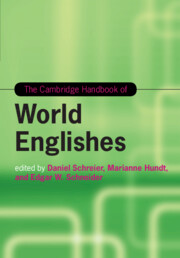Book contents
- The Cambridge Handbook of World Englishes
- Cambridge Handbooks in Language and Linguistics
- The Cambridge Handbook of World Englishes
- Copyright page
- Dedication
- Contents
- Figures
- Maps
- Tables
- Notes on Contributors
- 1 World Englishes: An Introduction
- Part I The Making of Englishes
- Part II World Englishes Old and New
- Part III Linguistics and World Englishes
- 14 The Global Growth of English at the Grassroots
- 15 Beyond English as a Second or Foreign Language: Local Uses and the Cultural Politics of Identification
- 16 World Englishes in Cyberspace
- 17 World Englishes and Their Dialect Roots
- 18 Lexicography and World Englishes
- 19 The Relevance of World Englishes for Variationist Sociolinguistics
- 20 Multilingualism and the World Englishes
- 21 Unearthing the Diachrony of World Englishes
- 22 Corpus-Based Approaches to World Englishes
- 23 World Englishes from the Perspective of Dialect Typology
- 24 Language Acquisition and World Englishes
- Part IV Current Challenges
- Index
- References
20 - Multilingualism and the World Englishes
from Part III - Linguistics and World Englishes
Published online by Cambridge University Press: 16 December 2019
- The Cambridge Handbook of World Englishes
- Cambridge Handbooks in Language and Linguistics
- The Cambridge Handbook of World Englishes
- Copyright page
- Dedication
- Contents
- Figures
- Maps
- Tables
- Notes on Contributors
- 1 World Englishes: An Introduction
- Part I The Making of Englishes
- Part II World Englishes Old and New
- Part III Linguistics and World Englishes
- 14 The Global Growth of English at the Grassroots
- 15 Beyond English as a Second or Foreign Language: Local Uses and the Cultural Politics of Identification
- 16 World Englishes in Cyberspace
- 17 World Englishes and Their Dialect Roots
- 18 Lexicography and World Englishes
- 19 The Relevance of World Englishes for Variationist Sociolinguistics
- 20 Multilingualism and the World Englishes
- 21 Unearthing the Diachrony of World Englishes
- 22 Corpus-Based Approaches to World Englishes
- 23 World Englishes from the Perspective of Dialect Typology
- 24 Language Acquisition and World Englishes
- Part IV Current Challenges
- Index
- References
Summary
The chapter provides an overview of the ways in which English has existed within a framework of multilingualism in all countries where it is spoken. The first part considers English beyond the shores of Britain, where it was initially introduced to contexts in which indigenous populations and their languages already existed, such as America, Canada, Australia, and New Zealand. Later, as English was introduced to countries in Africa and Asia that were colonized by the British, such as Nigeria and India, it added to the multilingual patterns that already existed in those places. English has continued to rise in importance in countries that have no links to a colonial history or where it has no official function; this is often linked to processes of globalization in the twentieth and twenty-first centuries. In these countries, English is often part of an individual’s multilingual repertoire. The chapter finally returns to Britain, where the myth of English monolingualism probably persists the most. Both historical and modern-day multilingualism are discussed and a case study is presented to demonstrate how multilingualism has impacted on the English variety spoken in London today.
Keywords
- Type
- Chapter
- Information
- The Cambridge Handbook of World Englishes , pp. 459 - 483Publisher: Cambridge University PressPrint publication year: 2020
References
References
Online References
Australian Bureau of Statistics. Cultural Diversity in Australia, 2016. www.abs.gov.au/ausstats/abs@.nsf/Lookup/by%20Subject/2071.0~2016~Main%20Features%7ECultural%20Diversity%20Article~20
British Deaf Association. https://bda.org.uk
The Canadian Association of the Deaf-Association des Sourds du Canada. www.cad.ca
Central Statistics Office – An Phríomh-Oifig Staidrimh www.cso.ie/en/census/census2011reports/census2011thisisirelandpart1/
Deaf Sector Partnership. http://deafsectorpartnership.net/bsl-scotland-act/
Department of Education and Skills. 20-year Strategy for the Irish Language 2010 – 2030. www.education.ie/en/Publications/Policy-Reports/20-Year-Strategy-for-the-Irish-Language-2010–2030.pdf Accessed 24th June 2018.
Department for Education (2015). Statistics: Schools, pupils and their characteristics: January 2015. www.gov.uk/government/collections/statistics-school-and-pupil-numbers
Department for Education (2015). Statistics: Schools, pupils and their characteristics: January 2017. www.gov.uk/government/statistics/schools-pupils-and-their-characteristics-january-2017 Accessed 1st October 2017
Ethnologue: Languages of the World. www.ethnologue.com
European Commission Eurostat. http://ec.europa.eu/eurostat
Government of Canada. 2016 Annual Report to Parliament on Immigration. www.cic.gc.ca/english/resources/publications/annual-report-2016/index.asp#s4.3
Isle of Man Census Report 2011. www.gov.im/media/207882/census2011reportfinalresized_1_.pdf
The Migration Observatory. www.migrationobservatory.ox.ac.uk
New Zealand Census statistics www.stats.govt.nz/Census/2013-census/profile-and…/quickstats…/languages.aspx
Office for National Statistics. www.ons.gov.uk/
Omniglot www.omniglot.com
Scotland’s Census www.scotlandscensus.gov.uk/
Scottish Government British Sign Language (BSL) National Plan 2017–2023 www.gov.scot/Resource/0052/00526382.pdf
Statistics Canada www12.statcan.gc.ca/census-recensement/2016/dp-pd/hlt-fst/lang/Table.cfm?Lang=E&T=11&Geo=00
Statistics Canada. Linguistic Diversity and Multilingualism in Canadian homes. www12.statcan.gc.ca/census-recensement/2016/as-sa/98–200-x/2016010/98–200-x2016010-eng.cfm
Statistics for Wales – ystadegau ar gyfer cymru. http://gov.wales/docs/statistics/2012/121211sb1182012en.pdf
Stats NZ. 2013 Census Quickstats about culture and identity. www.stats.govt.nz/Census/2013-census/profile-and-summary-reports/quickstats-culture-identity/birthplace.aspx
United States Census Bureau www.census.gov/data/tables/2013/demo/2009–2013-lang-tables.html
- 2
- Cited by



